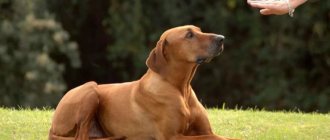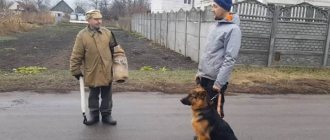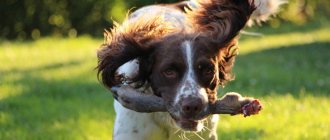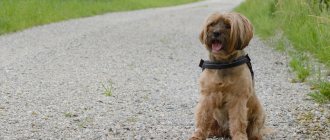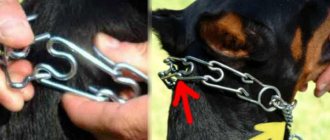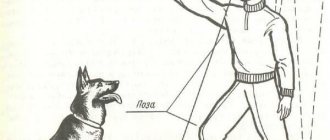After purchasing a pet, the first thing most owners ask is how to teach their dog the “Sit” command? The “Sit” command is practiced using a contrasting method, that is, both coercion and encouragement are important. Coercion is used by hand pressing on the dog's sacrum, and reward is praise and treats.
Usually, a puppy begins training this command at the age of 3 months.
You can teach your dog the “Sit” command both at home and on the street. The main thing is that the place is calm (without other animals, people, cars) and clean, as it will be unpleasant for the pet to sit in the mud.
Approach your dog holding the treat in your right hand. Say “Sit!”, then gently press with your left hand on her sacrum (butt), and move your right hand with the treat up and slightly back. When the pet sits, give the reward and after a few seconds release it, commanding “Walk.” Repeat the exercise several times at intervals of 3-5 minutes.
If you need to train an adult dog that is not familiar with the discipline to the “Sit” command, it will be useful to use a leash. With your left hand, press on the dog’s butt, and with your right hand, slightly pull the leash back and up. Praise and reward your pet when he reaches the desired position.
Usually, a couple of repetitions are enough for the pet to begin to sit without mechanical influence on your part.
At what age should you start training?
You should not try to teach anything to a puppy before three months. It's dangerous and useless. Young pets cannot concentrate on something for long enough, and the process of training at an early age is traumatic.
Do not think that it is no longer possible to raise an adult four-legged friend. The training process will require much more time and effort, but training a dog is a necessity.
Do not forget that training is a way of establishing a hierarchy between the owner and the pet, and this, in turn, is a matter of safety.
Rules for compliance with standards
According to the regulations, after giving an order by voice or gesture, the dog must turn its face towards the owner and take a sitting position within 3 seconds. In this position she needs:
- carefully select the hind legs, which serve as the main support;
- place the front paws shoulder-width apart;
- stretch your neck forward and upward, meeting the person’s gaze.
The position must be maintained until the owner allows it to be changed, but not less than 15 seconds. Skill practice is counted upon successful demonstration from a distance of 15 meters.
How to choose a place to study
It is very important that your pet feels safe and comfortable during training, so when choosing a place for training, it is worth studying its habits.
Most puppies feel comfortable around their owner, regardless of their environment. In this case, training can be carried out not only at home, but also on the street.
*It is important to consider distractions: puppies have a hard time focusing, so any little thing can become a distraction. Avoid dog parks at first.
If on the street your pet constantly clings to you, asks to be held and does not want to explore the area, then you should not try to train it outside the home. All of the above are signs of fear and anxiety.
They will not only interfere with the learning of commands, but will also lead to negative reinforcement, which will complicate training in the future. In this case, your home will be the best choice for a place to study. It is advisable to choose a room in which your pet spends most of the time. But not too close to his “place”, because the puppy’s personal space should remain a place to rest. Over time, the fear will pass, and classes can be safely transferred to open areas.
If you keep your pet in an enclosure, then under no circumstances conduct training in it. Invasion of personal space can make your pet want to dominate, making it more difficult to establish a hierarchy.
When dealing with an adult dog, pay attention to the hair near the tail and in the withers area. She stands on end when aggression occurs. Be wary at the slightest hint of this. In this case, it is better to entrust education to professionals.
You might be interested
How to teach a dog the command Near. Teaching a dog to walk next to you
These tips will help you teach your puppy or adult dog to walk next to you. Remember which of you…read more
How to teach a dog the “give paw” command - we will analyze it step by step, indicating errors
Beginning dog breeders sometimes believe that the command “give me your paw” is simply a kind of transfer of human relationships to ...read more
How to teach a dog the “Lie Down” command - tips from dog handlers
What actually is training and what is it actually needed for? After all, any dog ...read more
How to teach a dog the “Come to me” command - tips from dog handlers
The “come to me” command, like any other command, is necessary to control the dog’s behavior. If you…read more
Which delicacy is better to choose?
When choosing an incentive prize, you should pay attention to the tastes of your pet. Most people prefer ready-made treats like jerky. But there are times when a dog follows commands much more willingly for a piece of fruit.
My CAO loves apples. As soon as you show her a piece, she immediately sits down and quietly waits.
But not all fruits and vegetables are created equal. There are those that can cause serious harm. Never feed potatoes, avocados, grapes or raisins.
Be careful with apples - their seeds contain cyanide, to which dogs are very susceptible.
If your pet's diet is based on dry food, do not try to use it for training. The treat should be desirable, available only after the command is completed.
Do not use sweet, salty, spicy, fried, cheeses, lard, sausages and other delights of the human diet. All this causes great harm to your pet and reduces life expectancy.
Some dog breeders use special dog cookies as a treat, containing a bunch of micro and macroelements. It is not only tasty, but also healthy: their fur is really thick and shiny.
Preparation for training
To teach your dog the “Sit” command, you will need to purchase comfortable equipment and rewarding treats. A roulette leash is not suitable for training; instead, you need to take a standard leash within 0.5 m.
Place
At first, it is better to practice the skill at home. Familiar surroundings and the absence of noise will make it easier to absorb new information.
You can move on to street training only after your child remembers all the basics. In this case, distractions will not interfere with him, but will only improve his existing concentration.
Time
Exercise a few hours after eating. A full stomach makes it difficult to concentrate, and a slight feeling of hunger will make tasty rewards more desirable.
“
At first, the duration of the lessons should be 5-10 minutes.
Focus on the well-being and mood of both your pet and your own. If weakness, fatigue and irritability occur, it is better to postpone training to another day.
The low duration of lessons should be compensated by their frequency. Be sure to give your dog short breaks, switching his attention to playing with a ball or other thing.
Treat
It is not recommended to use regular dry food as a tasty reward. Treats should be desirable, so use dog biscuits or sausages. These treats need to be combined to prevent addiction.
Planting principles
Always pay special attention to the health and comfort of your pet. But at the same time, make sure that the command is executed correctly. Relaxation during training will show your pet that he can control the process for you.
The dog should look at you when performing a command and be focused on your actions. To do this, you need to attract her attention: call her name, show her a treat, pet her.
You need to carefully monitor the correct landing. It should not be performed on the thigh (as if on the side).
The support when executing the command should be on the hind legs (bones, heel and metatarsals). Improper execution of a command can harm your health and cause discomfort.
Before you begin training, look at your dog when he is standing. You will notice that the distance between pairs of paws is greater than when your pet is sitting. This suggests that trying to simply press on the dog's sacrum to execute a command is incorrect.
There are techniques that can help you achieve the correct fit.
- Movement of the back pair . The front paws remain in place. Then with your left hand, press down on the sacrum and push it forward a little. Make sure that the distance between the paws is not too small. In this case, the dog will take an incorrect position, which will cause him discomfort.
- Movement of the front pair . This technique can be used with both a treat and a collar/leash. The back pair of paws remains in place. The front ones move. Either by moving a tasty reward or by pulling on the collar/leash. Make sure your dog doesn't sit on your thigh.
Do not use a roulette leash, only the standard version is no longer than one and a half meters. Take your pet's favorite toy with you - this can also act as a reward option, only during breaks between approaches.
Stages of training
Dog training is not an easy task and requires a lot of time and patience. In the process, you need to move gradually from simple to complex, from undebugged execution to accurate and trouble-free execution. To begin with, the dog must understand what is required of it (in this case the Sit command), and in this it needs help. Every correct action of the dog must be rewarded in order to form a positive reinforcement. This is very important at this stage of training. Wrong or erroneous actions should not be encouraged.
- The first stage is at the very beginning of training, the dog may be distracted by strangers, surrounding noise and other external factors. Therefore, classes should be conducted in a fairly quiet and secluded place.
- The second stage involves similar conditions for training, during which you need to hone the conditioned reflex to the command. To consolidate, they use restraint during execution, and also accompany the actions with an appropriate gesture. Positive reinforcement of correct actions is again used, and delays allow the dog to learn to more willingly and accurately carry out the trainer's gestures and commands.
- The third stage is necessary for further consolidation of acquired conditioned reflexes. Training is already taking place in a new environment for the dog with additional stimuli: strangers, animals, vehicles, noise, etc. To slow down the excitement from surrounding stimuli, the trainer has a different kind of influence on the pet: changes the tone of voice, repeats the command, uses mechanical impact. For final consolidation, numerous training sessions and repetition of what has been learned before are needed. All commands, including “Sit,” must be executed accurately and without failure.
A step-by-step method for training a puppy and an adult dog
After you have determined the optimal landing option for you, selected a treat and chosen a place, you can begin the learning process itself. Make sure there are no other animals or people around.
You need to monitor the behavior of your four-legged friend during training. This is especially important in the case of training large breed puppies (especially herding ones, such as Alabai), since hip dysplasia is common among them. The pet should not be hungry or thirsty. The best option is to start the lesson an hour before feeding and take water with you.
Training with treats
The most common method, suitable in most cases only for puppies. In fact, this is reinforcing the team with their favorite food.
- You need to stand to the left of the dog. Her attention should be focused on what is happening, and her gaze should be directed forward.
- Take out the treat and take it in your right hand.
- Say your pet's name to get attention, then give the command "Sit!" Your voice should be clear and fairly stern.
- Let your dog see and smell the treat to get him interested.
- If you chose the first landing option, you should:
- hold a treat in front of your pet;
- make it clear that you will not give it away so easily;
- With your left hand, lightly press on the sacrum.
If you chose the second one, then you should:
- without sudden movements, raise your hand with a treat above your head;
- If the dog is interested, but does not sit down, gently press on the sacrum and make it clear that he will not receive the reward just like that.
After the dog has followed the command, praise it (“well done,” “good dog,” or a reinforcement sound), reward it, and pet it.
Continue to monitor your pet’s position for 5-7 seconds, and then command “Walk.”
Then let the dog rest for a few minutes. At first, repeat no more than three to five approaches at a time. Afterwards, when the pet follows the command perfectly, give the treat less often (every other time, then after three, and so on), but do not forget to praise and stroke it. This way, over time, your pet will wean itself off food reinforcement.
Training with a leash
An excellent option for hyperactive and adult dogs, as well as overly temperamental large breed males. Great for cases when the pet does not want to land, but is simply trying to snatch the treat.
- Place your pet to your right. Pull on the leash, but not too much.
- Attract your pet's attention by calling his name. Then turn slightly towards the dog and grab the leash with your right hand at a distance of 15-20 cm from the collar fastening.
- Give the command “Sit” and use the second landing method, pulling the leash up and back, but not too much. If the dog refuses to comply with the command, combine both methods and apply a little pressure on the sacrum. Make sure there is enough space between pairs of legs.
- If your pet is old enough or hyperactive, after boarding it is worth repeating the command again, and then praising and petting it. Don't forget about the treats.
- The dog must wait for the “Walk” command before standing up. Pause for 5-7 seconds.
If your new friend is overweight, it will be very difficult for you to cope with him. If you understand that your strength is not enough, it is better to seek help.
Gesture training
The next step on the path is to execute the command after the gesture. This will not only help you better control your pet's behavior, but will also teach him to always keep you in sight.
- Stand in front of the dog, attracting attention - say his name. Show me the treat.
- Holding the treat in your right hand, raise it to shoulder level. Command “Sit.”
- After landing, give the treat and praise.
- Hold the command and then release.
Over time, increase the distance between you to two meters. After the pet has learned to follow a command only by gesture, increase the distance and holding time again.
Gradually, the dog will have to land at a distance of 15-17 meters, and maintain it for at least 20 seconds. At this stage, you can start combining it with “Come to me!” and wait!".
Landing in difficult conditions
This is a very important stage in raising a shaggy family friend, who will teach her how to behave in difficult and dangerous situations. This will also allow you to show your pet how to behave correctly in places where dogs and people gather.
She will learn to follow commands regardless of the environment. This will help avoid unpleasant situations, such as trying to play with the neighbor's children.
You can start by sitting in a room with another person, or asking your friends to hang out with you. Then give the command when your pet is interested in the game.
Gradually move to more crowded and noisy places. Don't do this every day, but alternate it with walks in the park. But don't forget about the muzzle, especially if the dog is large.
Walking dogs without a muzzle in public places is prohibited.
If your pet has a thick undercoat, using snowdrifts as obstacles is a great way to practice the exercise in challenging environments. But remember: urban snow is doused with dangerous chemicals. It's better to go to the fields.
Reflexive execution of a command.
Perhaps this can be called the last step to the title of an exemplary dog. To master this skill, your pet must know other basic commands.
Practice the “Nearby” command for some time. It is advisable to do 2-3 approaches. Then do another one, but at the end say “Sit” and hold for 5-7 seconds. Praise, reward, take a break and repeat 2-3 more times.
Gradually increase the time, change direction when executing the “Near” command. Bring the landing to automaticity: the dog must perform it when stopping. Make sure your pet is always on the left. Try changing direction without a leash.
No less important is the connection with the “Come to me” command. Thanks to this combination, the dog will be more manageable. If you need to distract her from playing, she will not just run towards the owner and continue playing with him, but will sit next to him.
- While at a distance from the dog (at least 4 meters), give the command “Come to me” and show the treat in your left hand.
- Once your pet is close, lower your hand along your body. The dog should approach you from the left side.
- Give the command “Sit”. If this does not work, try putting your pet on a leash first.
- Praise and reward. Don't forget about endurance.
Positive reinforcement method
This training method is based on the puppy's natural desire to receive a treat. Show the puppy a piece by holding it up to his nose and letting him smell it. When the dog becomes interested, say: “Sit!” Move your hand with the piece up above the dog’s head. Trying to follow the treat with his eyes, the pet will sit down by inertia. Because this way it will be more convenient for him to observe the treat.
Advice! When teaching your dog any skills, use sound signals “Yes” or “No” so that the dog quickly understands the results of his actions.
Teaching the command “Sit!” method of positive reinforcement: Photo.
Possible mistakes
Irregular exercise can be harmful. Try to do the exercises daily.
Never use physical force when training. This is always negative reinforcement, which can cripple your pet’s psyche.
Don't use the same treat for too long. Alternate between different types. And don't use too big pieces.
Don't overexert your pet. Overtraining is overworking the nervous system. If you notice that your pet is reluctant to follow commands, postpone training until tomorrow.
Incorrect use of intonation during training will harm the result. Commands should be given clearly, quite loudly, but there should be no anger in the voice. This way your pet may think that you are scolding him. Reinforcing praise should be gentle, less loud.
Don't forget to take breaks between sets. They should be long enough for the pet to rest and get distracted. The retention should not be too long.
Don't get distracted while doing the exercises. This is an extra chance for the pet to seize the initiative. Stay focused and composed. Don't let overly energetic pets turn training into play.
Useful tips
- Increase the duration of the training and the number of commands given gradually after the initial lesson, which usually lasts 10-15 minutes. The main thing to remember is that the dog should not get tired, but should exercise with pleasure - so you should not exercise with it for too long.
- During the training process, also practice commands with your dog that it already knows, and add variety to the training.
- Always praise your dog when he succeeds, even if the pet does not receive a treat every time for correctly performing a command.
- Start teaching a gesture command after practicing all other types of command execution. To reinforce a skill using a gesture, reinforce it with a voice command each time.
- Do not use brute physical force as punishment.
- Be restrained and do not succumb to the animal’s provocations when, for example, it wants to play during training.
- Give the “Walk” command only after the dog has spent time in place after sitting down.
- If the animal jumps up without your command “Walk”, it should be returned to its place and the command must be executed correctly.
A firm decision to teach your dog the “Sit” command and patience will bring you and your pet success. Teaching this skill, like raising a dog in general, is not always an easy task. But for your efforts you will be rewarded with a well-mannered and obedient friend who, if necessary, will come up to you, sit down and stay nearby for the desired time.
Photo: kimikimchi
And with the right approach to training, you will be able to receive feedback - the love and devotion of your pet.
Briefly about the main thing
- The “Sit” command is the first command in every dog’s life, which lays the foundation for training and behavior.
- Emotional contact and praise are important, but it is equally valuable to be strict at times.
- There is no need to act recklessly; you should pay attention to temperament and habits.
- Choose a method that suits you personally, but do not forget about the comfort and health of your pet.
- Regardless of your age, repeat the exercises at least once a week - this will preserve your skills and reactions.
- The right approach will help you become best friends and give your four-legged friend many years of happiness.
Did you like the article? Share it with your friends on social media. networks. This will help them get useful information and support our project.
Benefit of the team
The “Sit” command is recommended for dogs undergoing obedience courses. Its development is practiced at UGS and OKD for the sake of developing endurance, attention and discipline. Adopting a sitting position when instructed by the owner makes it easier to learn more complex skills such as “Down” and “Give Paw.”
